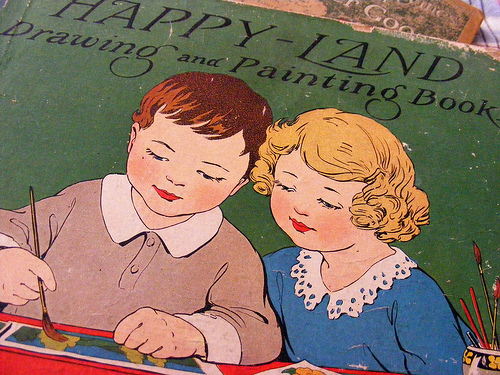
Credit: Photograph by Dana Graves under an Attribution-NonCommercial-NoDerivs 2.0 Generic license
Image: Photograph of 1923 “Happy-Land Drawing and Painting” book cover showing two children painting together.
I was recently talking to someone about multiplayer games because she was in the process of developing a game that she initially thought could just as well be done as a single player educational game. However, the real issue was what multiplayer really meant. I have previously put forth the idea of Big OER versus little oer. There is similarly multiplayer and Multiplayer. Some incredibly popular games are really multiplayer. In a multiplayer game, multiple people occupy the same space simultaneously, but the environment or the game does not foster cooperation or teamwork. It may even be the case that what those other players do does not affect you at all directly. A good example of this is Zynga’s Farmville. In Farmville, you have your farm, you plant your crops, and you buy whatever the nifty thing of the day is. You can interact with your neighbours or your friends, but it is not required or necessary to progress through all the content of the game. Another example that came to mind was GuildWars. It sounds like you should be forming guilds and interacting with other people, but for many people it was initially very much a solo game. The game even supported solo play by allowing you to hire NPC mercenaries to go on missions with you.
Contrast this with true Multiplayer games where you do significantly better if you cooperate and group with other people or where the entire premise of the game is based around small communities of people. For example, in World of Warcraft, most of the content is not accessible to solo players. Solo players can complete independent quests, but good rewards, in the form of better gear, are available from five-, ten-, or twenty-five player instances. In those scenarios, what you do does affect other people and they are often not afraid to let you know it. If you fail to play well or appropriately, if you are in a random group of people—called a “pick up group” or PUG—they may kick you out of the group or verbally abuse you or both. Extremely difficult content is hard to play in a pick-up group. It has been developed for cohesive groups of people, where the people are used to playing together either because they are all in a community together, like a guild, or because they are a regular cohort of players in a raiding group. Each player in a group in one of these larger adventures is important. Each person has a role to play. Each person can contribute to deciding how the encounters are going to turn out by their skill or their tactics.
What does true Multiplayer have to offer over multiplayer or single player experiences in an educational game? True Multiplayer brings a lot. Where one person’s activities and behaviour can impact the play of another means that an awareness of other people is required. In addition to this being a real-world necessary skill for teamwork and relationships in general, it means you need to consider how your actions impact others, both positively and negatively. It also means you have the opportunity to enter into a dialogue with those other people about the best way to accomplish similar goals. Similar goals are one of the lynchpins of communities and shared learning goals facilitate forming communities of practice and the dissemination of information and practice, whether that is skills, game goods, or knowledge. These are all fostered by a true Multiplayer game but much, much more difficult to achieve in multiplayer games where participants merely occupy the same space simultaneously without impacting each other’s activities. It is probably almost impossible in a single player game.
You can probably more easily visualize the difference if you consider two five year-olds who are not friends in the same room colouring. They occupy the same space but each child has his or her own page on which they colour. After some time passes, you might notice that each kid is talking aloud. It sounds like self talk: “Now I’m going to colour the sky blue.” The utterance is really aimed at the other child but it has no impact. ”multiplayer” games are the same. You can talk about what you are doing, but what you are doing does not much power to affect what a second person is doing. Notice that I said “much”. That is because if you can converse, you can exchange knowledge, even if the goal shared is not identical or even if their activity does not impact your own. The colouring children, however, have the option to slowly, over time, drift into a shared activity, working together on the same drawing. That is the opportunity unavailable in multiplayer but fostered and encouraged by true Multiplayer games.







